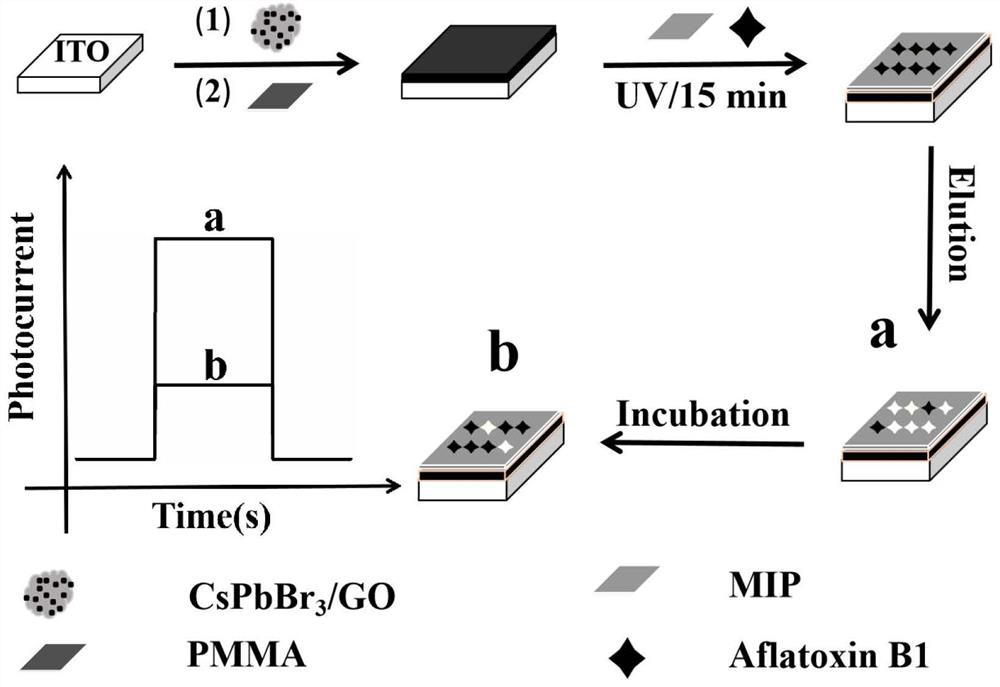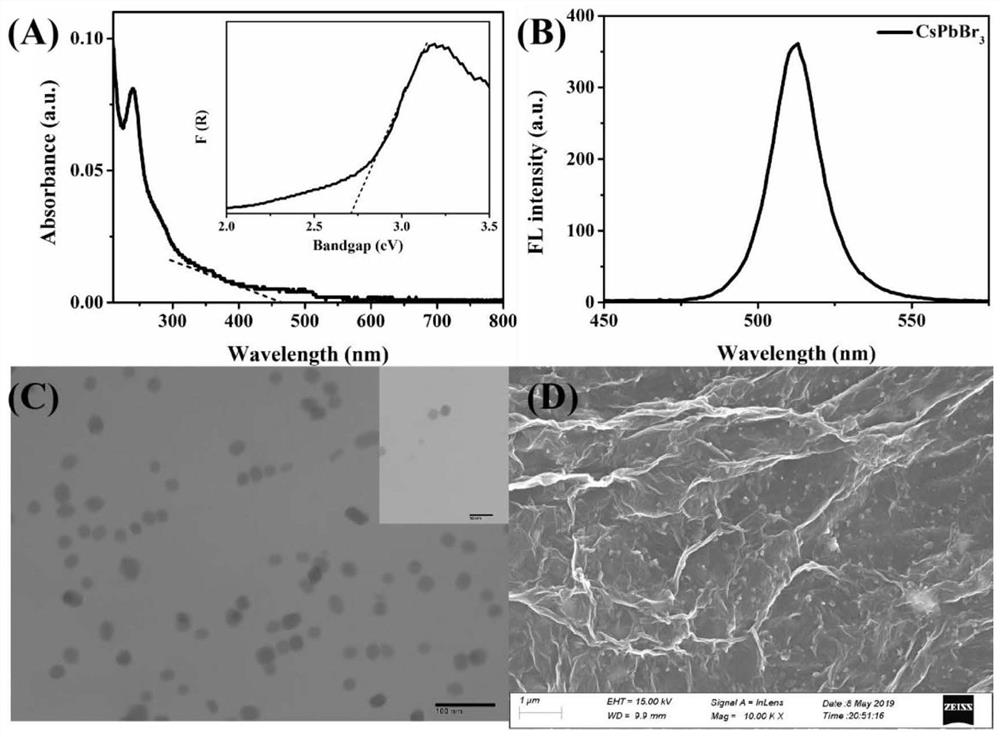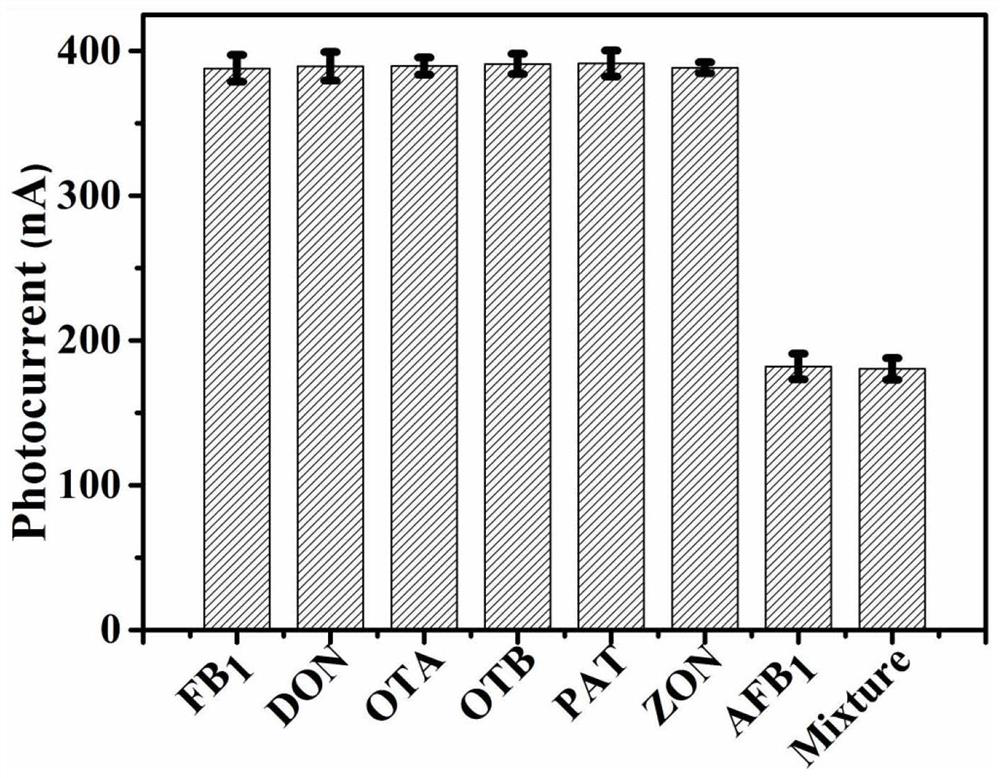Based on cspbbr 3 Molecularly imprinted photoelectrochemical sensor with /go homotype heterostructure and its preparation method and application
A molecular imprinting and heterostructure technology, applied in the fields of electrochemical variables of materials, scientific instruments, instruments, etc., can solve the problems such as the inability to meet the needs of optoelectronic devices, and achieve the effect of reuse, good application prospects, and improved selectivity.
- Summary
- Abstract
- Description
- Claims
- Application Information
AI Technical Summary
Problems solved by technology
Method used
Image
Examples
Embodiment 1
[0049] Example 1CsPbBr 3 and CsPbBr 3 / GO preparation, the preparation process is as follows:
[0050] CsPbBr used in the present invention 3 Is referring to Li Zhichun et al in the literature (Highly Luminescentand Ultrastable CsPbBr 3 The method reported in Perovskite Quantum Dots Incorporated into a Silica / Alumina Monolith, Li Zhichun et al, Angewandte Chemie International Edition, 2017, 129, 8246-8250) and slightly modified. First, 10 mmol of cesium carbonate, 20 mL of 1-octadecene and 20 mL of oleic acid were added to a round-bottomed flask, vacuumed at 120 °C for 05 to 1 hour, and then the reaction temperature was raised to 150 °C or less under argon flow. An optically transparent solution is formed, and after reflux for 0.5 to 1 hour, the solution is cooled to obtain the precursor CsOA. Then 20 mL of 1-octadecene, 5 mL of oleylamine, 5 mL of oleic acid and 2 mmol of lead bromide were added to the three-necked flask, and vacuumized at 120 ° C for 0.5 to 1 hour; The ...
Embodiment 2
[0051] Example 2 Preparation of molecularly imprinted photoelectrochemical sensor, the preparation process is as follows:
[0052] The molecularly imprinted polymer film used in the present invention refers to Mao Lebao et al. in the literature (Molecularly imprinted photoelectrochemical sensor for fumonisin B 1 Based on the method in GO-CdSheterojunction, Mao Lebao et al, Biosens. Bioelectron. 2019, 127, 57-63). First take 20 μL of the CsPbBr prepared in Example 1 3 The / GO solution was drop-coated on a clean conductive glass (ITO) electrode, and placed in the air to dry; then 20 μL of PMMA was added dropwise and dried in the air to obtain a modified electrode. Next, drop 20 μL of AFB containing the original concentration of 20mg / ml on the modified electrode 1 Template molecule, functional monomer methacrylic acid (MAA), cross-linking agent of ethylene glycol dimethacrylate (EDMA) and polymerization solution of initiator azobisisobutyronitrile (AIBN), in which AFB 1 Templa...
Embodiment 3
[0053] Example 3 Molecularly imprinted photoelectrochemical sensor to AFB 1 Specific detection, the detection process is as follows:
[0054] Add different toxins, such as Fumonisin B, to the rice extract prepared for the sensor prepared in Example 2 1 (FB 1 ), Deoxynivalenol (DON), Ochratoxin A (OTA), Ochratoxin B (OTB), Patulin (PAT), Zearalenone (ZON), Patulin (PAT) and Aflatoxin B1 (AFB 1 ) and contains AFB 1 Incubated with a mixture of all the above toxins, the results are as follows image 3 As shown, the concentration of interfering substances is 10ng / mL, AFB 1 Concentration is 1ng / mL, it can be seen that the interfering substances have no effect on the signal acquisition of the sensor, while adding AFB 1 Afterwards, the current changed significantly and was consistent with the sensor signal of the mixture culture, showing that the sensor was sensitive to AFB 1 There are good options.
PUM
 Login to View More
Login to View More Abstract
Description
Claims
Application Information
 Login to View More
Login to View More - R&D Engineer
- R&D Manager
- IP Professional
- Industry Leading Data Capabilities
- Powerful AI technology
- Patent DNA Extraction
Browse by: Latest US Patents, China's latest patents, Technical Efficacy Thesaurus, Application Domain, Technology Topic, Popular Technical Reports.
© 2024 PatSnap. All rights reserved.Legal|Privacy policy|Modern Slavery Act Transparency Statement|Sitemap|About US| Contact US: help@patsnap.com










